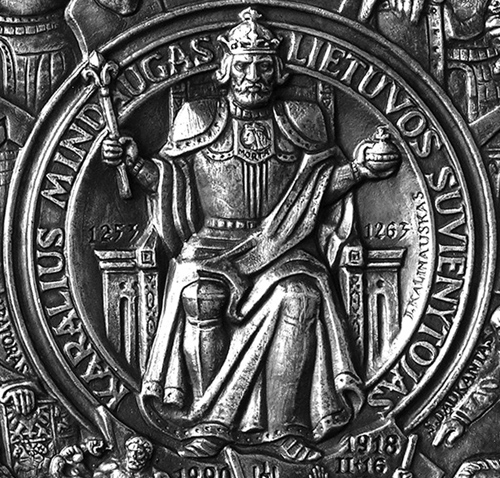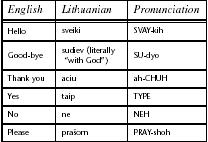Besides being one
of the only countries that sells used Mitsubishi parts for reasonable prices
(unlike the US), I’ve heard about Lithuania for years. My dad coached middle
school girls’ basketball for over 25 years, and we’d sometimes go see the
Indiana Pacers play when I was a kid. About ten years or so ago, the Pacers had
a good player from Lithuania named Sarunas Jacikevicius who played with them
for a couple years before being traded. It was then when I realized that
basketball was super popular in Lithuania.
It’s not exactly
clear where the name Lithuania comes from. The Lithuanian word for their
country, Lietuva, is thought to derive from the word for “pour” or “spill” and
may refer to a small river. It also may stem from a folk tale source that the
country is named after “a rainy place.” Another theory is that it’s related to
a word meaning “to unite,” referring to the unification of lands that is now
considered Lithuania. And most likely (I’m guessing), the word “Lithuania” as
used in English is the Latinization of Lietuva.
Lithuania is located
in Northeastern Europe, bordered by Latvia to the north, Belarus to the east,
Poland to the south, and the Russian exclave of the Kaliningrad Oblast to the
west. Lithuania also borders the Baltic Sea and is directly across the sea from
Sweden. Because of its location, Lithuania typically experiences mild summers
and cold winters. However, the country has seen a warming trend since the
1960s.
 |
| Mindaugas as set on a coin, looking mighty fierce |
Originally a
collection of various Baltic tribes, a guy by the name of Mindaugas was the
first to unite them all as Lithuanians. He was later made their king, and 13
years later was assassinated (he should’ve opted for the early retirement
package). The pagan lands were often the target of the Livonian Order and
Teutonic Knights. The country expanded and at one time included part of
Ukraine, Poland, Russia, and Belarus. After the Grand Duke of Poland ran the
place, they went on a dramatic Christianization of Lithuania, one of the last
places to officially adopt Christianity. When Russian forces grew, Lithuania drew
closer to Poland at the onset of the Livonian War. Years of being tied to
Poland led to an increase in Polish culture being merged with Lithuania’s. The
Swedes ravaged the country during the Northern War and the Great Northern War
during the later 1600s and early 1700s. Between the wars and a plague and
famine at the same time, Lithuania lost nearly 40% of its population. Most of
Lithuania then became part of the Russian Federation, where the Russians banned
most Lithuanian culture. It failed mostly due to the book smugglers who
supported secret homeschooling initiatives. Lithuania finally declared its
independence in 1918, but the matter of territory was a point of dispute
between Poland, German, and Lithuania. The temporary capital was set in Kaunas
while Vilnius, the historical capital of Lithuania, was still annexed by
Poland. Once Poland relinquished the city, the capital moved back to Vilnius.
The Soviets returned to Lithuania during WWII and pretty much stayed until
Russia broke up in 1991. After gaining their independence once more, Lithuania later
joined NATO and the EU and switched to a free market economy.
 |
| Old Town |
Coming in at just
over a half-million people, the capital city of Vilnius is Lithuania’s largest
city and second largest in the Baltic States after Riga, Latvia. This city has
been considered the capital since the early 1300s. Vilnius is known for its Old
Town, which was included as a UNESCO World Heritage Site in 1994. In fact,
Napoleon dubbed the city “the Jerusalem of the North.” Vilnius is known by many
different names, mostly as Vilna or Vilno (or some alternate spelling of each).
Today, this city located in the southeastern corner of the country is very much
a world-class cultural city, complete with museums, universities, parks, sports
venues, theatres, and a modern infrastructure.
Although Lithuania
saw a decline in their economy during the Global Economic Crisis of 2008-2009,
it has seen an increase in recent years, a continuation of the growth it saw in
the previous decade. They also utilize a flat tax rate rather than a
progressive rating system; both the personal income and corporate tax rates are
set at 15%, which is one of the lowest in Europe. Lithuania is transitioning to
growing their knowledge-based economic drivers such as biotechnology,
telecommunications, and information technology. Having strong banking and
financial centers allow for a number of international corporate offices to be
headquartered there.
Since Christianity
was brought to Lithuania during the 14th century, the country has
predominantly been Christian, and by far Roman Catholic. There are small
numbers of Orthodox and Lutherans, but there are more people who don’t adhere
to any religion than any of the non-Catholics put together. Historically, there
was a significant Jewish population in Lithuania, but after the Holocaust, that
number has now been reduced to about 4000 today.
The official
language is Lithuanian, both written and spoken. It’s considered a Baltic
language and is related to Latvian. Lithuanian uses the Roman script but is
amended with a few extra diacritical marks.
A friend of mine is
Lithuanian, and I’ve been waiting to do this country for a long time. She’s
told me how amazing the food is (well, ok, probably most of it—every country
has that one crazy dish), and I’ve had to wait nearly a year before I finally
get the change to try it. But now, I only have to wait one more week, and it’s
mine. I get to make this meal on Valentine’s Day, and what better way to
celebrate the people I love than with Lithuanian comfort foods.
Up next: art and
literature






No comments:
Post a Comment